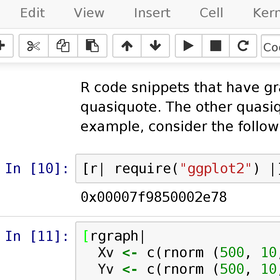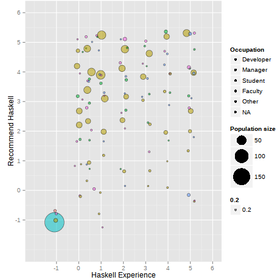The full power of R's extensive standard library at your fingertips, plus virtually all CRAN packages, which work from Haskell just as they would from R.
Optional type annotations let you leverage the full power of Haskell's type system to program R safely. Region-based memory allocation means precise and predictable memory usage without the dangers: Haskell's type system has your back to statically guarantee the absence of use-after-free bugs.
Zero marshalling language interop, for crossing language boundaries extremely efficiently at runtime. Mapping an R function over a million element container from Haskell is just as fast as from R.
Haskell is a statically typed, purely functional programming language with a state-of-the-art native code compiler.
R is an old but effective programming language sporting one of the most comprehensive sets of libraries for statistical analysis.
HaskellR is an umbrella project bringing together a number of packages for statistical analysis and machine learning in Haskell using R's comprehensive library support. Including:
 R's powerful graphing facilities at your fingertips:
R's powerful graphing facilities at your fingertips:
 © 2015 FP Complete Corp.
© 2015 FP Complete Corp.
{-# LANGUAGE QuasiQuotes #-}
{-# LANGUAGE ScopedTypeVariables #-}
import H.Prelude as H
import Language.R.QQ
import System.Random
main = H.withEmbeddedR defaultConfig $ do
H.runRegion $ do
-- Put any complex model here
std <- io $ newStdGen
let (xs::[Double]) = take 100 $ randoms std
d <- [r| matrix(xs_hs,ncol = 2) |]
rv <- [r| clusters <- kmeans(d_hs, 2) |]
[r| par(mar = c(5.1, 4.1, 0, 1));
plot(d_hs, col = rv_hs$cluster, pch = 20
, cex = 3, xlab = "x", ylab = "y");
points(rv_hs$centers, pch = 4, cex = 4, lwd = 4);
|]
return ()